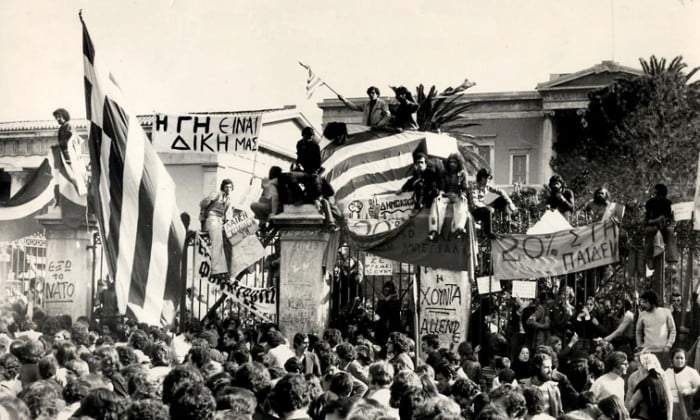
The Athens Polytechnic uprising occurred on November 17, 1973, as a massive student demonstration of the popular rejection of the Greek military junta of 1967 to 1974.
The uprising that began on November 14, 1973, escalated to an open, anti-junta revolt and ended in bloodshed in the early morning of November 17th after a series of events, starting with a tank crashing through the gates of the Polytechnic.
As of November 1973, it had been six and a half years since Greece had been placed under strict, far-right military rule. Opponents of the junta that took over in the April 21, 1967 coup had been tortured, jailed, exiled, or put under surveillance ever since that time.
The referendum, which elected dictator Georgios Papadopoulos as President of the Republic and Spyros Markezinis as transitional Prime Minister in October, and the promise of elections to be held in February of 1974 could not appease the Greek people, who simply wanted their freedom.
Greek students began the first demonstrations against the regime in February and March of 1973. On November 14, 1973 students demonstrated at the School of Law and entered the Polytechnic School (Polytechneio) building on the corner of Patission and Sournari Streets about oe hundred meters away from the National Archaeological Museum of Athens.
Brave students stood up to Junta in Athens Polytechnic Uprising
By evening, police had asked them to leave the premises, so the students decided to occupy the Polytechneio building in the first phase of the Athens Polytechnic Uprising. Additional people had heard about the uprising by word of mouth, and they came to join the group at the school.
A jury-rigged radio station was somehow set up there, and the call was then broadcast, inviting all Greeks to come to the Polytechneio and protest against the junta.
Behind the microphone was 21-year-old student Maria Damanaki. The repeated phrase “Polytechneio here! Polytechneio here! This is the radio station of the free, fighting students, of the free, fighting Greeks!” still echoes eerily in the minds of those who heard the announcements in those strange, ominous days.
By Friday, November 16, the Polytechneio building and the surrounding area were packed with people who had gone there to protest. Some had gathered out of curiosity since it had been years since demonstrations had been allowed.
Suddenly, police surrounded the area, stopping the influx of people to the building. The authorities started calling on the crowd to disperse and threatened them with violence.
Tensions were high and there began to be reports of shootings and killings of people by the police.
24 Protesters were killed when a tank crashed into the gates of the Polytechnic
By nightfall, all the protesters moved inside the campus of the Polytechnic, and the authorities decided to call in the Army. By 1:30 AM a tank stood menacingly in front of the gate, with police repeating the calls for people to come out of the Polytechnic building and disperse — but the students and the rest of the protesters did not budge.
The Junta’s tank crashed into the gate of the Polytechnic campus at about 3 AM. Some grainy footage shot by a Dutch reporter shows the vehicle tearing down and crashing through the main steel gate of the university as people still clung to its railings.
From inside the building, the radio announcer was pleading with the soldiers to not carry out the orders of their superiors and hurt their “brothers,” his voice emotional as he recited the national anthem before the tank entered the yard and the transmission ended.
While many of those who were in the yard were crushed and some killed by the tank, the Army and police allowed the protesters inside the Polytechneio to leave unharmed from the Stournari Street gate.
The total number of recorded deaths amounted to 24 civilians killed outside the Athens Polytechnic campus.
These include 19-year-old Michael Mirogiannis, reportedly shot to death by officer Nikolaos Dertilis, high-school students Diomedes Komnenos and Alexandros Spartidis of Lycee Leonin, and a five-year-old boy caught in the crossfire in the suburb of Zografou.
The records of the trials held following the collapse of the Junta document the circumstances of the deaths of many civilians during the uprising, and although the number of dead has not been contested by historical research, it remains a subject of political controversy.
In addition, hundreds of civilians were left injured during the events.
On November 25, just days after the Athens Polytechnic Uprising, brigadier Dimitrios Ioannidis staged a coup, overthrowing Papadopoulos and Markezinis.
The new dictator established an even more harsh regime, but it ended several months later upon the failed coup attempt in Cyprus which brought about the Turkish invasion of the island on July 20, 1974.
See all the latest news from Greece and the world at Greekreporter.com. Contact our newsroom to report an update or send your story, photos and videos. Follow GR on Google News and subscribe here to our daily email!



